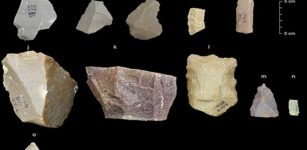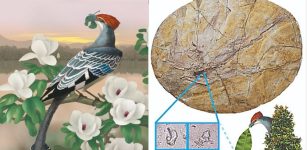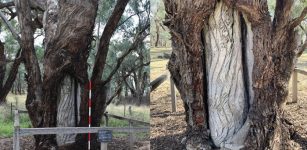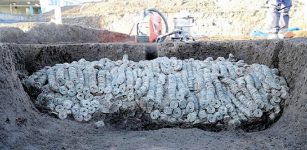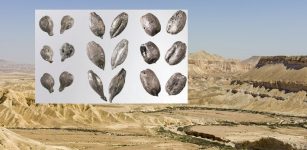The Hitra Man Lived In A Turbulent Time – Was He A Stone Age Warrior?
Conny Waters - AncientPages.com - In 1916, a road ascending towards the Fausland farm, located on the island of Hitra, Norway, underwent a process of enhancement and refurbishment. The gravel used for this work originated from the shoreline situated in the innermost reaches of Barmfjorden.
NTNU University Museum has recreated the Hitra man as he probably looked: approximately 169 cm tall, fair-haired and blue-eyed. The model of the Hitra man was created by Thomas Foldberg. Credit: Åge Hojem / NTNU University Museum.
The excavation crew encountered an unexpected and significant discovery among the sand and stones – it was human skeletal remains. These bones belonged to an individual estimated to be approximately 25 years of age at the time of his death, which occurred during the final stages of the Stone Age era, approximately 4,000 years ago.
This remarkable find holds immense historical and archaeological significance, offering a rare glimpse into the lives and circumstances of our ancient ancestors.
The archaeological evidence suggests that the individual in question met an untimely demise by drowning. At the time of his passing, the sea level was substantially higher, approximately 12.5 meters above its current state, rendering the discovery site submerged at a depth of 4 meters.
Archaeologists found this arm guard along with the bone remains. Credit: Jenny Kalseth
Notably, portions of the skeletal remains exhibit remarkable preservation, indicating that they were promptly covered by shell sand on the seabed shortly after the individual's demise, as stated by archaeologist Birgitte Skar from the NTNU University Museum.
The archaeological site yielded significant findings, including bone remains, a dagger, and an arm guard. The arm guard is an oblong-shaped bone artifact with two holes, indicating it was designed to be attached to the wrist of the hand holding a bow. Its purpose was to protect the wrist from the bowstring's impact during the arrows' release. This discovery provides valuable insights into the weaponry and hunting practices of the ancient civilization.
According to Skar, the artifacts found alongside the Hitra man's remains suggest he may have been a warrior. However, Skar notes that it is impossible to determine whether the drowning was a result of combat or an accidental occurrence. What is known is that the Hitra man lived during a tumultuous period in history. Prior to his time, most people subsisted as hunter-gatherers, and it was not until the very end of the Stone Age, when the Hitra man lived, that agriculture became firmly established in Norway.
"Elements of agriculture had been introduced in southern and eastern Norway earlier, but in central Norway, along the coast in the west and in northern Norway, agriculture was first established during this period.
We believe that agriculture was introduced by migrating people who arrived in Norway to get more land—and they were willing to use weapons to do so. We must therefore expect that there were violent clashes between the people who already lived here and the newcomers," says Skar.
The arrival of the new people introduced novel knowledge and practices to the country. They brought expertise in animal husbandry and agricultural techniques, which contributed to the development of these sectors. Additionally, they introduced alternative approaches to social organization, offering insights into different societal structures and systems.
"They lived in hierarchical societies, had a different understanding of the world, another religion, and a large network of contacts down in Europe.
This knowledge led to major changes, politically, economically and socially," says Skar.
Scandinavian history during this dramatic era remains shrouded in mystery, and ongoing research efforts are underway to unravel its intricacies. The Hitra man discovery, alongside numerous other skeletal findings, is a significant part of this investigative process.
Island of Hitra. Credit: Adobe Stock - tomtom747
His DNA is currently undergoing rigorous analysis at the prestigious Lundbeck Foundation Center for Geogenetics at the University of Copenhagen. This comprehensive examination has the potential to shed light on the enigmatic aspects of this captivating historical period.
At NTNU University Museum, researchers have been employing isotope analysis to uncover valuable insights about the Hitra man's life. This analytical technique provides information about his dietary habits and potential migration patterns during his lifetime. The findings reveal that the majority of his diet consisted of terrestrial food sources, despite being discovered in a location that was submerged underwater at the time.
Bone remains from the Hitra man. Credit: Ole Bjørn Pedersen
As Skar explains, "We already know that the vast majority of the food he ate came from the land. So even though he was found on Hitra—in a place that was underwater at the time—it wasn't primarily seafood he ate." This suggests that while the Hitra man lived in a coastal area, his sustenance was primarily derived from land-based resources, offering a glimpse into the lifestyle and subsistence patterns of that era.
The Hitra man's appearance has been meticulously reconstructed at the NTNU University Museum, drawing upon various scientific methods. Skeletal measurements indicate that he was approximately 169 cm tall, and the wear patterns on his teeth suggest he was around 25 years old at the time of his death.
See also: More Archaeology News
DNA analyses of individuals from the same era with similar genetic profiles have provided insights into his hair, skin, and eye color. This comprehensive approach has enabled researchers to recreate a lifelike representation of the Hitra man.
As investigations continue, it will be fascinating to uncover further details about this individual and the society in which he lived, shedding light on an intriguing chapter of our shared history.
Written by Conny Waters - AncientPages.com Staff Writer







